
I tend to love and gravitate toward games that are divisive amongst the gaming community rather than those that garner more universal critical acclaim, and the most recent example of this is Suda51’s latest masterpiece, Lollipop Chainsaw, earning plenty of my love while also cutting some sharply divided opinions from the community.
But any art that sparks such differing viewpoints will forever be more interesting than art that everyone can agree upon, and thus has the potential to live longer through discussion and debate. When it comes to art that exists in part as a reflection of a variety of past works, enjoyment can come not only from the piece itself, but also from appreciating its references and inspirations.
Grasshopper Manufacture, Kadokawa Games, and Warner Bros. Interactive Entertainment have pooled their creative efforts to bring the world one of the most thoroughly enjoyable pieces of entertainment I’ve experienced this year and, if talking exclusively about games, even this console generation. But appreciation of a game in a vacuum is one thing – appreciation of a game in context of existing pop culture is something completely different, and quite frankly, is where this game shines.
The premise of Lollipop Chainsaw is immediately absurd, nicely setting itself up for the reveal of more craziness as the adventure unfolds: Cheerleader Juliet Starling, excited about celebrating her 18th birthday, finds herself in the middle of a zombie outbreak at San Romero High. Conveniently, she also happens to be a zombie hunter and carries a full-size chainsaw in her gym bag. You know, just in case this sort of shit happens.
Given the recent surge of zombie popularity in pop culture, Lollipop Chainsaw comes to us at a time when many people might be feeling a sort of zombie fatigue. Yes, The Walking Dead is its own phenomenon, enjoyed by both newcomers to the TV series and long-time fans of its source comic – but zombies have also become a sort of instant cash-in, especially for games publishers. Following Left 4 Dead, someone got zombies in our Call of Duty. Dead Space’s necromorphs pulled on the same fear receptors that former survival horror franchises like Resident Evil and Silent Hill did years ago, and Dead Island takes us on our worst holiday ever. So while it’s understandable that some might simply be sick of zombies, it’s also important that Lollipop Chainsaw offers a refreshing take on zombie-slaying games: its humorous approach in dealing with the undead. In this respect, the game has been compared to Buffy the Vampire Slayer and on a superficial level that could be all the comparison one really needs to make. But the way the game feels compelled me to draw my own comparisons, especially in light of its brand of humor.
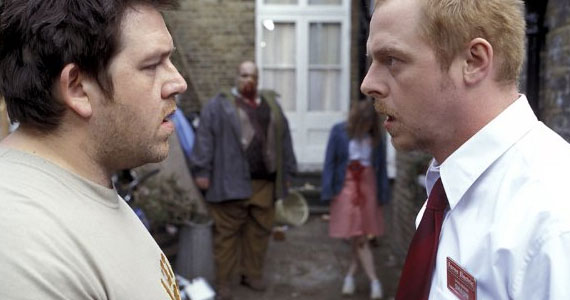
Of course, this isn’t the first time we’ve seen zombies in a funny light. In 2004, Edgar Wright’s Shaun of the Dead presented a realistic look at how real people might cope with such an outbreak. Although that film is billed mainly as a comedy it still includes moments of horror, drama, and sadness. In fact, part of why I think it’s a great movie is because of the way it balances and switches between these feelings.
But Shaun of the Dead wasn’t the first funny zombie movie. For a much earlier example, let’s travel back in time to a year forever rooted in time travel: 1985. Return of the Living Dead (not affiliated with George A. Romero’s Living Dead series) had the dead coming back to life thanks to a foolish mishap at a medical supply warehouse. Apart from balancing laughs with horrific and gruesome moments, Return of the Living Dead also included its fair share of pop culture references, like when the characters of Burt, Frank, and Freddy are freaking out while discussing how to kill a zombie:
Burt: I thought you said if we destroyed the brain, it’d die!
Frank: It worked in the movie!
Burt: Well, it ain’t working now, Frank!
Freddy: You mean the movie lied?
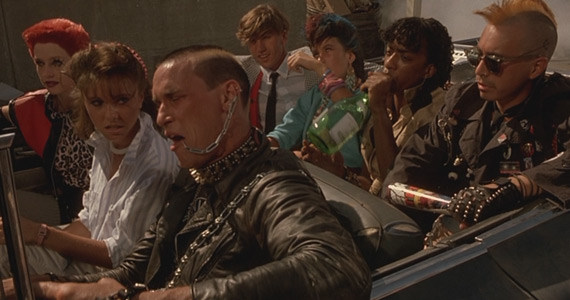
Most of the movie’s promotional artwork features depictions of zombies with punk aesthetics, and the more memorable of Return of the Living Dead’s cast are by far the comically exaggerated punk rock characters including Spider, Trash, and Scuz, to name a few (Suicide’s line, “You think this is a fuckin’ costume? This is a way of life!” will forever crack me up). But it’s not just the humans that are funny in the movie. Upon killing police, a zombie gets on the cop’s CB radio to have the station, “Send more cops!” What we have in Return of the Living Dead – the balance of humor, gore, absurdity, talking zombies, and rock music – makes for a cheesy yet genuinely enjoyable movie.
It also provides what appears to have been fantastic inspiration for much of Lollipop Chainsaw. After all, the game is packed with humorous dialogue of characters reacting to messed up situations that are often disgusting and/or absurd, many of the zombies utter some hilarious lines, and of course the game has a rockin’ soundtrack as well as bosses reflective of different sub genres of rock. But in case this inspiration wasn’t clear enough, look no further than the location of the game’s third stage: O’Bannon Farm. Return of the Living Dead was directed by Dan O’Bannon, who also wrote the screenplay. On the topic of zombie director references, the game’s arcade Fulci Fun Center is homage to legendary Italian director/”Godfather of Gore” Lucio Fulci (who directed Zombie [AKA Zombi 2], a movie where a zombie FIGHTS A SHARK UNDERWATER!), not to mention of course the more obvious San Romero being homage to George A. Romero.
Every chef has his favorite spices and as with No More Heroes, Suda51 has seasoned almost everything in Lollipop Chainsaw in such a way as to pay respect to something else that came before it. Although I picked up this game entirely for fun with neither intention nor assignment to ever review it, I quite often paused the game to make a mad dash to my notebook to scribble something down to look up later. This momentary break from the action would have been annoying were the moments used to answer a phone call or the call of nature, but when pausing to jot down notes, the game was all I had on my mind and I never left its world.
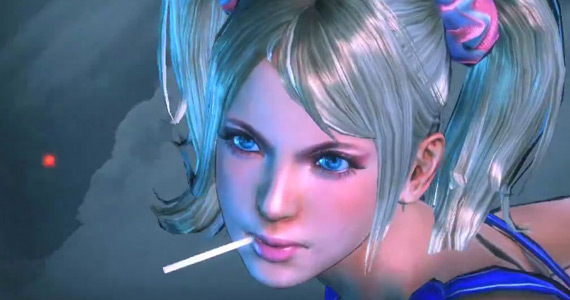
Although we experience Lollipop Chainsaw as Juliet, she’s not the only zombie hunter in the story. She comes from a family of hunters, and they hunt much more than just zombies. We learn that Juliet has killed all manner of foul beasts from Yeti to Frankenberries. Her sisters Cordelia and Rosalind (who like Juliet are also named after Shakespearean characters) make appearances throughout the game, in some cases helping and in others needing to be helped.
The Romeo to Juliet’s, um, Juliet, is hapless jock Nick Carlyle who unfortunately gets bitten by a zombie and therefore has to spend the rest of the game as a magical decapitated head. Nick provides a fair amount of the game’s comedic relief while at the same time playing the part of the cynical skeptic by questioning the absurdity of it all, bringing more absurdity in having a talking decapitated head calling out absurdity. As an extra nice touch, Nick’s reactions mirror things people would say about the game while trying to dismiss it as being stupid – and this is very smart. To a lesser extent, Juliet also calls out irritating and stupid moments in the game, letting us know in no uncertain terms, “Hey! You with the controller! We’re on your side, dummy!” acting as a pre-emptive strike against profanity shouted at the game. This also helps us as players to buy into this world and accept that fucked up things are going to happen and that we’ll have to deal with them.
As expected from the game’s title, the chainsaw plays a big role in how we dispatch enemies. Juliet has a variety of ways of dishing out the damage, and given that we’ve been conditioned by most games to place an over reliance on the best of weapons, it’s expected that players will resort – or attempt to resort – to using the chainsaw exclusively. This is where I feel some people have had an unnecessarily tough time with the game, passing off the combat as being clunky while not realizing it was what they made of it.
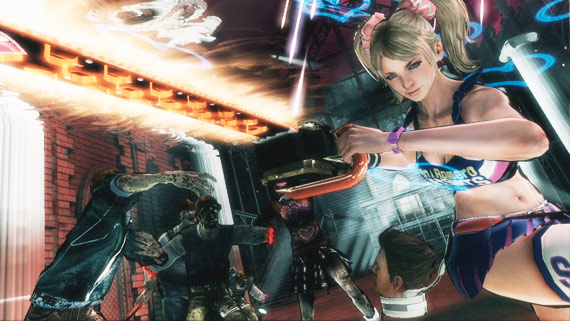
The approach that works best is to actually think about the situation. Again, something that brought me into the game even more: How would Juliet actually fight? She’s a cheerleader and a professional killer of evil things. Naturally, she’d be quick and she’d jump around a lot, leapfrogging, dropkicking, and otherwise using the fastest attacks. Standing in one spot and swinging a heavy chainsaw at one enemy when seven surround you is an unwise tactic and, if you’re particularly sensitive about sucking at videogames, a recipe to ensure you won’t have a good time. The more fighting you do, the more zombie medals you’ll accrue to upgrade Juliet with flashier and more effective combos to take on even tougher enemies.
That said, there are still moments where the game could feel better, particularly when using the Chainsaw Blaster. The weapon’s setting defaults to auto-aiming, which will only work to your advantage about half the time. It does always focus its sights on an enemy, but it won’t necessarily be the enemy that’s the most important one to kill at that time. I found that turning automatic aiming off did wonders for my aim but still found the aiming, like the game’s manual camera tweaking, to be somewhat slower than I would have liked. In all, it’s a minor grievance considering the overall experience.
The stages are punctuated by encounters with stronger zombies who act as mini bosses and they end in fights with one of the Dark Purveyors determined to bring the world to its doom. In typical Suda51 style, each of these bosses offers up outlandish and offensive dialogue. The purveyors themselves are caricatures based on different sub genres of rock music, from punk to death metal to psychedelic to rockabilly.
One of the more memorable boss fights for me was with Mariska, the psychedelic boss who makes Juliet play through sections of the stage while hallucinating and who ultimately splits herself into eight selves prior to her defeat. The number eight carries great significance; it’s considered a lucky and ancient holy number in Japanese culture. But more applicable in this case, the loving Hindu goddess Lakshmi has eight forms, and despite Mariska’s intention to kill Juliet, she does still come across as loving and at peace. But perhaps even more applicable a correlation is to the Buddhist idea of the Noble Eightfold Path, which is an eight-step means to end suffering and lead to Nirvana. Considering that the first of the Four Noble Truths of Buddhism states that to live is to suffer, the end of suffering is to achieve enlightenment, which is exactly what Mariska does while dying. She even says, “heavy,” on her way out, which I realize is exactly what looking this far into a videogame boss encounter is – but what is art if not something that’s open to interpretation?
I should reiterate that I played Lollipop Chainsaw for fun – and like all games I play for this reason I spread my playtime with it across multiple nights, completing one chapter per night until I was finished (though I’m still playing it now attempting to unlock every combo, costume, and upgrade). It’s a somewhat short game but some of the stages, like O’Bannon Farm where I clocked in just under one hour of playtime to finish everything, feel quite large. On top of this the game’s ranking mode offers extra incentive to replay stages even after unlocking everything to earn higher scores.
This, combined with how much I’ve been thinking about the game, has certainly made the purchase well worth my money and I’m more than happy to support Suda51, Grasshopper, Kadokawa, and Warner and urge them to continue to make games that I can appreciate on more levels than just the superficial joy of combat. I’ll be playing Lollipop Chainsaw for weeks to come, and I’ll probably make other crazy conclusions about parts of the game.
Art is a funny thing. The only reason it gets made is because an artist chooses to express him or herself. Then it gets put out into the world for people to examine, scrutinize, praise, or damn. Everyone finds different meaning – his or her own meaning – in a piece. This opinion is based on what we already know and love from previous works of art, be it a film, album, game, or painting. With this in mind, I happily accept that not everyone is going to like the same stuff I like. But damn it, I really fucking love Lollipop Chainsaw.
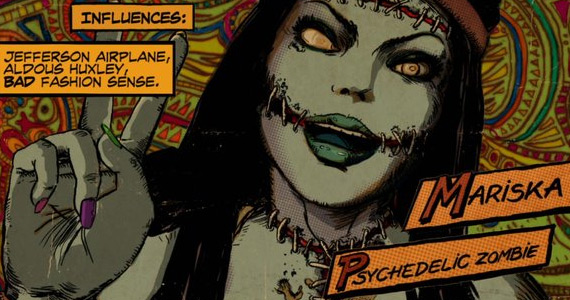
I see your point of view. I tend to gravitate to games that have a little friction too. Not so much your GTA killing hookers, but I got Mad World on the Wii since it was gratuitous violence on the Wii which was fairly unprecedented and not appreciated by all.
(Also, Shaun of the Dead is one of my fav movies)
-A
Comment by A Parker — June 23, 2012 @ 6:47 pm
Some of my favourite releases that were not overly appreciated over the last few years have been on the Wii, definitely Mad World, also Silent Hill Shattered Memories.
Comment by Jamie Love — June 23, 2012 @ 7:32 pm
MadWorld for Wii was pretty cool in that it was horribly super violent but also hilarious. It did make me uncomfortable a few times, but it’s up there when it comes to games of this generation that I’d recommend to people.
Comment by megashaun — June 26, 2012 @ 12:03 am
Interesting. I have not really been all that enamoured with Suda 51, but I have not really had the chance to live with any his work for a sufficient time. Killer 7 passed me by when it came out and No More Heroes did the same. I will probably give this a look at some stage. It must be said however, on the zombie fatigue point, that Dead Rising 1 & 2 did this resolutely wacky comic approach superbly, as well as transforming the dynamics of Dawn of the Dead into a video game – so much so that it had to state that it was not related to Romero’s work at all on the cover, even when it clearly fucking was. Return of the Living Dead is a very good point of reference. (I may be wrong on this but I believe that Return of the Living Dead *is* related to Night of the Living Dead, legally speaking, as Romero lost the rights to continue to use the Living Dead title for his series.) And any game that namedrops Lucio Fulci is probably one worth considering. City of the Living Dead is an excellent sort of zombie movie. Zombies too, haven’t really had their supreme outing in video games – and really folks getting tired of zombies or any other horror staple just don’t seem to have the stomach for necessities of the genre – The Last of Us I reckon will provide something very close to the definitive video game zombie / horror experience. Although Dead Space 1 & 2 were pretty exquisite horror games, they were more from the Lovecraft school as a result of Event Horizon being from that school (through Stuart Gordon and Bryan Yuzna) and Dead Space being a translation of that movie, which was itself just Solaris done as a horror picture.
Comment by JerryStillwell — June 25, 2012 @ 10:33 pm
Hey! Thanks for this comment! You’re right that Return of the Living Dead actually is related to Night of the Living Dead in the sense that Tom Russo retained the rights to use the term “Living Dead” after he and Romero had worked on Night of the Living Dead. This is probably why subsequent films in the “Living Dead” proper series do not contain those words in their titles. However, it’s not related in the sense of affiliation or being part of the series. Meanwhile, Night of the Living Dead’s in the public domain, which is unfortunate because there’s a bad iOS game made based on it, using its name. On the upside, Night of the Living Dead: Re-Animated was pretty cool! Have you seen it?
I didn’t mentioned Dead Rising in this article, but yes, I remember actually thinking for a while that it WAS affiliated with Dawn of the Dead until I actually got it and saw that somewhat prominent disclaimer on the front cover!
The Last of Us does look promising, but as far as proper zombie games go I still love the GameCube remaster of the first Resident Evil (though the acting is SO SO BAD.).
Okay, lastly – if you feel the urge to get into Suda51 games I do recommend getting No More Heroes 2: Desperate Struggle for the Wii. Killer 7 is really messed up, but it sounds like you could probably handle it.
Thanks again for your thoughts! I need to go watch City of the Living Dead now. I can’t remember if I’ve seen it.
Comment by megashaun — June 25, 2012 @ 11:59 pm
I haven’t seen Night of the Living Dead: Re-Animated, I must check it out! I knew the Living Dead thing was some weird tangled legal history. I think Dan O Bannon only agreed to do it if he could completely separate it from Romero, right?
The two Gamecube Resident Evils were excellent, particularly the remake. It would be amazing if they re-did 2 but I’d guess that possibility has passed. Still a beautiful looking game. I was very happy to play the DLC with Chris and Jill in RE5, which went back to the dark mansions, the creepy dungeon and all that. If you haven’t played that it’s well worth a look. Only short – maybe just over an hour if I remember correctly – but is a lovely mixture of the aesthetic of the originals with the combat of 4 on. I have some serious hopes for 6, given it finally abandoning the dreary locations that became the standard from 4 – country side, sand, rocks – and getting back into the city! I’ve wished for a Resident Evil set in a big city since 2 came out.
It is wonderful that the Wii is backwards compatible, unlike the bloody PS3 (argh), as I can still throw on all those games. Killer 7 should be easy enough to get a hold of. Eurogamer did a good retrospective on it a while back:
http://www.eurogamer.net/articles/2012-04-29-retrospective-killer7
He reminds me a good bit of David Cage, in his courage to make games feature these conceptual art bits that are surrounded by varying degrees of recognizable “game”. The more folks do this kind of thing, the less we have to have the silly argument about what qualifies as a game or not. (Answer is o’course: anything but we’re still a long way from accepting that) I also appreciate how overtly Japanese he is, in his style and ideas, even when the setting is ostensibly Western. He’s one of the few folks still making batshit crazy games filled with divergent humour that is not obsessed with courting ahem the Western market or whatever. Dead Rising 2 was outsourced to an American lot primarily because of this fear. Even though I greatly enjoyed it, it didn’t have quite the ultra crazy Japanese flair that the original had – and even then it was still far too American in its flavours.
City of the Living Dead is the first one by Fulci I saw. It is quite extreme. It has I believe real animal intestines and other organs that folks are forced to expel from their bodies. It’s a bit strange, and features some of the worst dubbing eveeeer – even worse than the Spaghetti Westerns – but if you can get over that, it’s a really fine movie. House By the Cemetery is my favourite though. Surprisingly poetic movie.
Comment by JerryStillwell — June 26, 2012 @ 12:20 am